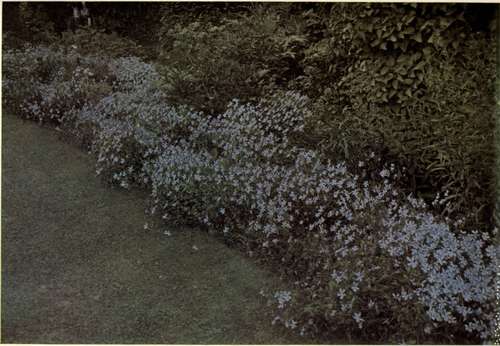Flower Edgings For The Garden
Description
This section is from the book "What England Can Teach Us About Gardening", by Wilhelm Miller. Also available from Amazon: What England Can Teach Us About Gardening.
Flower Edgings For The Garden
But the most affecting loveliness, in my opinion, is that which comes from the use of flowers for edging garden walks. Take, for instance, the white pinks shown on plate 93. These unpretentious little flowers, that crouch at one's feet, appeal to one's protective instincts like helpless children. But they do their work marvellously well. They smother all weeds; they define the walks; they fill the air with the scent of cloves in June; they are covered with flowers during their season; their silvery foliage is attractive even in winter; and they soften and glorify the lines of garden paths. It is no wonder that Mr. E. T. Cook says (in the "Century Book of Gardening") that they are the most popular of all flowers for edgings.
My own impression, however, is that tufted pansies are the favourites in England at the present time. They have one great advantage over pinks in blooming all spring and summer, with the exception of a fortnight's enforced rest. Pinks bloom once and are gone until next year. There are several "everblooming" pinks in the catalogues, but I have never seen any I cared for. Either they have poor colours or poor form or else they split their calyces. Doubtless there are many fine pinks I have never seen, but surely tufted pansies bloom longer and they are also available in a wider range of colours — blue, yellow, violet, etc. These tufted pansies, or violas, have smaller flowers than the ordinary kinds and will actually bloom freely through our hot summers. Some idea of their charm may be had from the picture at plate 94, which, however, shows one of the simple old types having the narrow petals of Viola cornuta, the chief parent of this race. The latest varieties are decidedly showier, because broader petalled. I expect to see millions of these pansies sold in America every year. The only drawback to them I know of is that they are said to get "sick of the soil" in two or three years, and have to be removed or they will give out suddenly. They cannot be regarded as permanent edging material, but they are certainly longer-lived than ordinary pansies, and you can propagate by cuttings the one variety you like best. I wish every one who reads this article would try some tufted pansies in a rose bed next spring. Or if you wish enough to edge a walk and cannot afford to buy the plants, get some seed and sow in flats in coldframes.

94. THE HORNED VIOLET {VIOLA CORNUTA), CHIEF PARENT OF THE TUFTED OR BEDDING PANSIES.
These, then, are the great edging plants in England — pinks and tufted pansies. For variety they use thrifts, which make neat evergreen sods and bear tidy balls of rosy flowers on long stems; moss pink (Phlox subulata), in refined varieties; rock-cress (Arabis albida); an exquisite harebell known as Campanula pusilla, which I fear we can grow only in rockeries, and saxifrages without number. These last we cannot grow, except possibly the London pride (Saxifraga umbrosa), which seems to me the most valuable of all because of its evergreen rosettes.
We particularly need white-flowered edging plants that bloom in summer. White, because white is the peacemaker in the garden. Summer-blooming, because white flowers make a garden seem cool and restful. If there is any nurseryman or amateur who has a white-flowered variety of the lemon thyme I wish he would send me some plants for experimentation as I think that would make an ideal edging plant for America — white flowers, summer bloom, evergreen, and fragrant foliage.
Continue to:
Tags
garden, flowers, plants, England, effects, foliage, gardening
